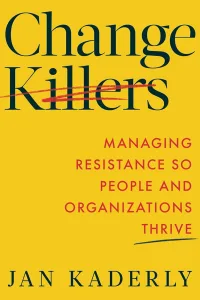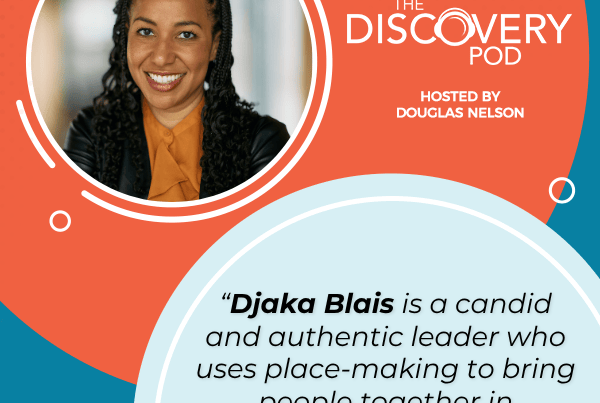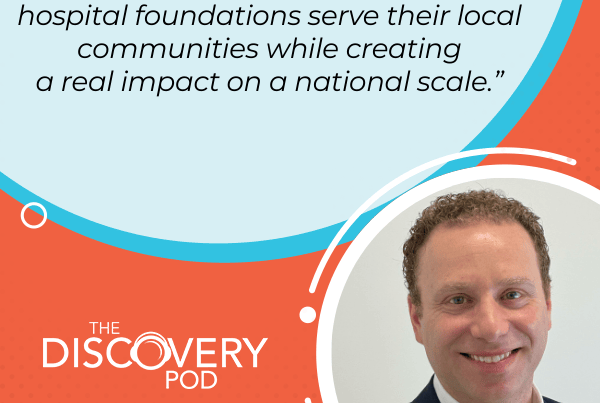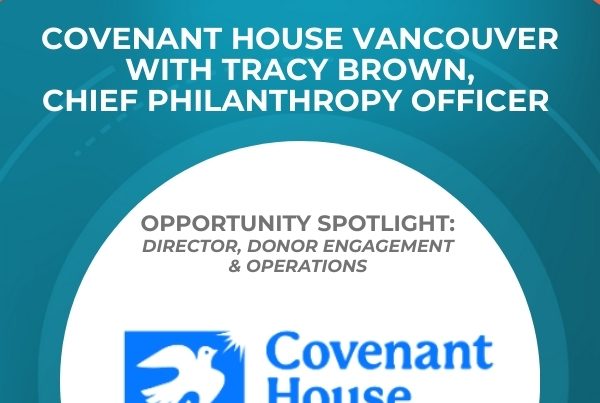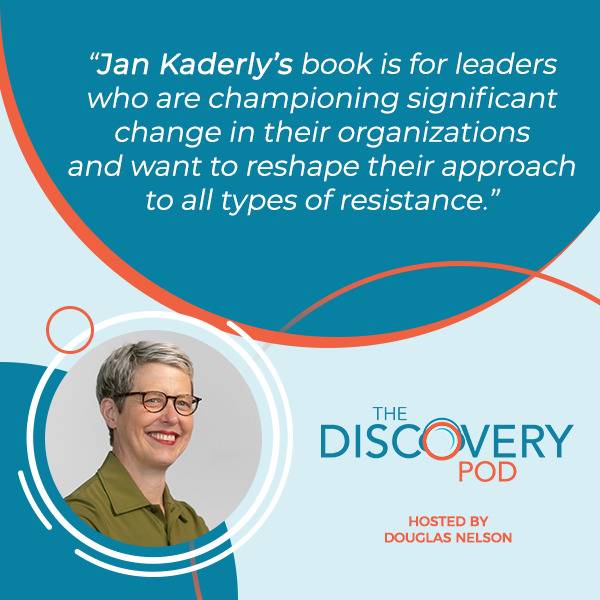
Change is inevitable, but resistance does not have to be. In this episode, Douglas Nelson speaks with Jan Kaderly, author of Change Killers: Managing Resistance So People and Organizations Thrive. Together, they dive into the human factors that often stand in the way of organizational transformation and how to better navigate these obstacles with confidence. Jan also shares eye-opening insights on why resistance is built into organizations and how leaders unknowingly create their own roadblocks. Whether you are leading a nonprofit organization or at the helm of a corporate team, this conversation will challenge the way you think about change – and give you the necessary tools to make it happen more effectively.
—
Listen to the podcast here
Change Killers With Jan Kaderly, Author
This is a very special edition of the show because I have my friend, colleague, and champion of the social profit sector, Jan Kaderly. Jan is the Founder of Brave Bird Consulting, based in New York City. Jan has also written a book that will change the way you lead transformation in your organization. Her book is called Change Killers: Managing Resistance So People and Organizations Thrive.
In our conversation, Jan talks about the human factors that get in the way of major change organizations within our social profit sector and how you, as leaders, can approach this change to not only reduce the amount of resistance you encounter but build coalitions to get big change done even faster and more effectively.
Jan’s book, the case studies that she goes through, changed the way I think about transformations, and it made me cringe at some of the mistakes I must have made earlier on in my career. It may make some of you cringe as well but cringe no more. Enjoy this conversation with Jan Kaderly and pick up her book, Change Killers: Managing Resistance So People and Organizations Thrive, as soon as you possibly can. Welcome back to the show, Jan.
Thank you, Doug. I’m a two-time interviewee.
There are very few of you. It is so great to welcome back a friend, an expert, and someone that I respect so deeply and who is doing great work in our sector. Jan, I wanted to have you back on because you wrote a book. You did it. It’s called Change Killers: Managing Resistance So People and Organizations Thrive.
Jan Kaderly, everyone should buy it. That’s the goal of this show, to sell these books, because it will help you, as leaders, think differently about how you manage change in your organization, how you will bring your human self to the process rather than a pro forma scripted structure that doesn’t work and makes people grouchy.
If I can just put a little twist on it, I don’t mean to just be the consultant with a clever twist on something, but I do believe, in the heart of hearts, managing change is literally managing resistance. You have successfully managed resistance.
What came through in reading the book was the number of ways that leaders inadvertently create their resistance to their own change and how leadership teams foster an environment where resistance can thrive rather than lowering those barriers and smoothing things out for many reasons. What’s the biggest reason?
Organizations Are Designed For Reliability, Not Change
I’ll just say what comes to mind, and maybe that’s the biggest, maybe it isn’t. Part of and one of the things that I found compelling about the book, and to answer your question, is that we have been trained, for lack of a better word, over many years, more than a decade, change or die. It is a dogma now that organizations need to change quickly to keep up with this, that, and the other. We idolize the technology sector for its fail-fast idea. All of this, this is glorified stuff, and we take it as a truth. What we fail to see underneath is that, in fact, modern organization, the thing that emerged from industrialization and all of that, the modern organization is about reliability.
It is about being able to do the same thing, day in and day out, reliably, and to be publicly accountable for doing that thing. It is because there are a lot of cheaper, easier ways to get stuff done in the world than to create an organization, for the love of God. It is an expensive way to achieve collective action. The reason you do it is for accountability, and the accountability is about creating that reliable performance. We have this kind of myth, change is good and it is necessary. I’m not saying it’s not. I’m agnostic. Good or bad? Who knows? You’ll see. You’ll find out.
It certainly does come into tension with the reality of what organizations do, which is to be reliable corporate performers. I think the reason resistance is inherent is because one of the things that struck me, it is built into the fabric, the structure of the organization. It’s in the job description. When a person leaves, the job description stays. In that job description, and the other job descriptions that surround it, are processes and routines. Those stay.
Resistance to change is inherent because it is built into the structure of an organization. When a person leaves their position, the job description stays. Share on XPeople come and go. These artifacts of organizations are what keep things going on reliably. I think we just fail to appreciate, number one, that’s the structural answer to the question. The many social and psychological answers to that question that we need to have today be like yesterday, tomorrow be like today, otherwise our lives would feel quite chaotic. The book goes on with all of the reasons this is hard. Those are two just off the top of my head.
The book is incredibly well-researched. Drawing from a lot of different sources makes a very compelling case. I shared, as we were getting ready to record, that I could identify individuals that I have worked with in my career, that I had in my head labeled those change resistors. As I read through the book about how resistance is encouraged, inspired, created by leaders making change, I became embarrassed. It’s like, I thought I was doing the right thing. I thought that was the right thing.
It was one of those. If I had known what I know now, after reading your book, I would have handled a lot of these situations very differently. I think that’s true of a lot of leaders in our sector. One of the questions that I wrote down in the margin of this book is a pet theory of mine that I’ve mentioned on the show a few times, which is that the organization, the world outside of the social profit sector is changing so much more quickly than the world inside the social profit sector.
I think that reliability and predictability come from being rooted primarily in scarcity, at least initially. What you’re walking through is a way to do this, to manage change, to manage resistance, in a way that would accelerate the pace if everyone was on board with it. It’s not necessarily about moving more slowly. It’s about communicating in a way that meets people through change.
That’s right. I’m interested. I want to go back to your theory, Doug, that other sectors are moving more quickly and more quickly than the social and nonprofit sectors, which makes the pace of change challenging within the sector.
I think it reinforces the slowness of change. It’s not just other sectors. It’s the world outside of our sector. The people that are served, the people who participate, the beneficiaries, the audiences that attend, the world is changing much more quickly outside than inside, which creates, I think, a low or high level of anxiety for a lot of leaders about needing to play catch-up. They’re leaning into this change, and they’re pushing harder as the answer. In this great book I just read, pushing harder and yelling louder isn’t always the best way. It is not the answer.
I think that your idea sparks a couple of thoughts for me. The first one is just a little tangential realization that I had at some point in the research. That is, change is potentially only a thing when you’re not initiating it. On any given day, we are going through a sequence of activities. We’re going with the flow of life, and in that flow of life, we’re probably changing. We’re probably doing something different now than we did before. We may or may not be registering it, but it’s certainly not the same.
Change Is Only A Thing When You’re Not Initiating It
It only becomes registered in our mind as change, in part, because we’re not the agent of it. There are all sorts of things that you’re changing and potentially imposing on others. You’re not thinking of it as, “We’re going to change this.” You’re just like, “Let’s do it.” It’s when someone else isn’t in control of it, when they are having to react to it, that we even code it as change.
That’s the resistance.
Change is only a thing when you’re resisting it or when you’re encountering the friction of it not happening. Whether you’re the aid, as I refer to it in the book, there’s the change taker and the change maker. One has agency, and the other has to respond. If we clear away all of the polite ways we have of talking about leadership, the thing I like about it is that there is a very clear element of power involved with it. There are those that are initiating it, and then there are those that need to implement it and go along with it. It’s in the reception of it.
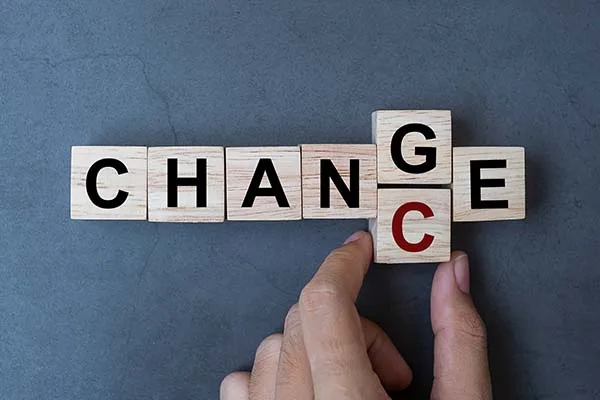
Change Killers: Change is only a thing when you are resisting it or when you are encountering the friction of it not happening.
It’s in having to accept it, to adapt yourself to it, to accommodate. That’s where it feels like change. Otherwise, it’s just like, “I have an intentionality in the world, and I’m just an actor out there doing my thing.” You don’t think of that as change. You think of it as, “Doug wants me to do this, and now I’ve got to change it up.”
You talk in the book about the basic needs that underlie resistance and the support for change, that it’s wired into all of us. Maybe spend a few minutes talking about what those basic needs that underlie resistance are.
It’s so funny because I spent two years researching the phenomenon of change in organizations, the structural, the social, the psychological, that deep phenomenon of change. Pretty much got that second half of the book done over two years. My goal was, is there a deeper or bigger, whatever, story to it? I didn’t do any more research and writing, and thankfully, my husband was also away for a couple of weeks. I just got to sit around, stare at a wall, and contemplate what I had done.
Me and the dogs, in silence, looking for the pattern. Is there something deeper here? I don’t know if it’s an invention or a discovery, but what became clear when you look at whether the resistance is in the form of rigidity, groupthink, or habits, all of this, you could see so clearly that the causes of resistance are these basic things. It felt like a discovery. Yet, it is so intuitive. Everybody will know them. It is the need for ease in our lives. The need to belong to a group. The need to have purpose and meaning in what we do. That need for stability. The need for integrity.
The people that we work with, and certainly at the upper end of an organization, our need to feel competent and in control. I don’t need to explain those terms, though. Everybody knows what that means. Yet, when you look at the research and case studies, you can identify why something went wrong. There are some fascinating case studies on organizational maladies.
I took those seven needs, and I went back to the case studies that are in the book. I said, “Do these needs explain how that went so wrong?” They did. The mutinies are always caused by a problem of integrity. How did Joseph Scanlon get it so right in the Depression with the collective effort at that steel mill with the workers? It’s because he tapped into their need for purpose. He made them feel valuable and competent. He leveraged a sense of belonging to their community to save the steel mill.
Using Basic Needs To Proactively Manage Change
You can take that lens and apply it to these different things. It felt like, “I think there is an explanatory power to this and a way of thinking about it that is familiar and better even.” The real exciting part for me was you can use those to be proactive in managing it. They’re basic. There are things you can do to facilitate purpose, to make people feel like there’s purpose and control, and all of it.
There’s a lot you can do, and you can also, without having a PhD, look at your change effort. “We’re going to do a deep reorganization, and let’s cut a bunch of budget too.” It doesn’t take a PhD to figure out what that is going to trigger. You’re going to be firing people. They have friends, the sense of belonging.
You’re going to be potentially cutting so deep that you’re going to compromise a core function of your organization, making people feel unstable. That’s in a lot of the case studies. You can take whatever your scenario is and, just using common sense, be able to say, “This is potentially where I’m going to be activating people, where it’s potentially going to be upsetting for them. Let me see what I can do to bolster them using those same needs.”
It’s such a useful framework to think about, thinking of, personally, how I’ve led change, how I’ve been a part of change in organizations in the past. In my work here with The Discovery Group, getting to work with organizations that are going through conceiving of and executing on change, I think I’m going to sound a lot more wise being able to talk about those elements of resistance because it explains why certain things don’t work.
I recall vividly, very early on in my career, when I was promoted too quickly, and some people who worked with me at the time thought that it had never stopped happening. I was too quickly promoted, and when I would get frustrated or when I would feel over my skis or underwater or whatever the analogy, no pleasant analogy, I would think, where’s the button or the toggle switch where it’s like, we’re going left, I want to go right?
I just want to be able to push the button or flip that toggle switch. I knew even then, and certainly, hopefully, I have learned to move away from that instinct of just needing this to happen now, which has a terrible impact on the team. It undermines what you’re trying to accomplish. It’s just not your best self showing up. That’s what I’m aware of in myself whenever I feel that. Where’s the button to push? I said we don’t do that anymore. I push this button, and now no one will do that anymore.
The command and control didn’t work.
I know that doesn’t work. I know that’s not the best side of me. What I thought was interesting in reading through Change Killers: Managing Resistance So People and Organizations Thrive was that there are ways for leaders to anticipate their own reactions as they’re leading change, to be deliberate in thinking about how they’re going to support and bring people on board, build coalitions, build that sense of collaboration within the organization, which is going to not only accomplish the purpose of change but build a much stronger organization as an example.
It requires some deliberate intentionality at the outset. I think sometimes, in organizations, it feels like we don’t have time for that. We don’t have time for niceties. We just have to do this. What would you say to a leader who is trying to balance that? We just have to get this done with wanting to bring everybody on board.
Hidden Cost Of Expediency In Implementing Change
I think it’s hinted at there, the expediency that you’re craving is potentially an illusion. There’s a significant amount, or you’re not calculating the cost correctly. You’ve got to take fast action. My guess would be that the knock-on effects of doing something significant, notice, I just want to make a note, Change Killers: Managing Resistance So People and Organizations Thrive is about disruptive change. It is, and I want to go back to disruption for a second because I think that’s an important topic. I think that there is a hidden cost to expediency.

Change Killers: There is a hidden cost to expediency.
I was talking to a friend. He’s in a large organization, they’re acquiring another organization, and he’s going to take on a significant, whole other team. Lots of delicacy around it. He was thinking he wanted to do it a certain way, very mindfully, and then all of a sudden, his boss just, boom, let’s get that email out the door. No one had any idea. Everybody got their reassignments, and everyone was completely caught by surprise and blindsided, as we call it in the business.
It took him weeks to undo the mess of people feeling, what’s happening? The sheer number of hours of conversation needed to sweep up the effects of blindsiding and how people feel out of control and vulnerable. For him, his boss may have thought that went well, but he was sweeping up the mess for weeks.
I think it’s important because I’ve always thought some change management practices, the ones that are with complex technology projects, they can feel a bit bureaucratic, like they take a whole project manager to pull off. It’s first, you do this. Second, third. Very sequential. What I advocate for in the book, and when I developed the cards to help facilitate, are quick actions. It could be Doug, like in your case. I know this is going to probably bother this person. Let me just go have a genuine conversation with them about why I feel I have to hurry.
If you show up being genuine, not dumbing it down or selling it hard, being genuine and saying, “I need your help,” people generally don’t want to fail others. There are just a couple of little psychological levers that you can pull and you can move fast and smoothly. It’s like a little checklist, who’s this going to rub? What’s it going to trigger for them? I’m giving you a vocabulary for that. What can I do? There’s lots. That’s the nice thing about those seven needs. There are a lot of things that you can do. It’s also not if you’ve got the framework for it.
People generally do not want to fail others. Share on XAll you have to do is spend three years researching this and writing a book, and it seems obvious.
You’ve made it easy.
For me, again, in our work with strategic planning, our work with boards, we often say we work with a task force that acts as the project team for whatever we’re doing with the board. Encouraging board chairs and members of the management team to bring people who may be resistant to this or those who are grouchy. Sometimes, we just say, is there anybody that’s going to be grouchy about that? Let’s bring them onto the task force.
Let’s bring them into the conversation. It feels so intuitive because you want them to be a part of it, to have some ownership, to feel like they’re heard. I know that they’ve been heard and their concerns have been addressed because you genuinely want to do that. That’s my experience with almost all of our clients, that they want to be heard, or that they want to hear from the people that are there, maybe disagreeing. It works so well because often you end up with a new champion, or you end up with somebody saying, I still don’t agree with this, but I see why we’re doing it a different way. It’s intuitive.
Reading the book is for leaders who are championing big change in their organizations. There’s got to be a similar model to bring those people who may be resistors, or likely resistors, not onto a task force or leadership team but to engage them in the process. Does that make sense? How would you advise leaders to start?
Importance Of Bringing Detractors Into The Process
It makes sense for so many reasons. To the CEO or to the board chairman who has identified a detractor or someone not fully on board, one thing that also struck me that I wanted to pull out, and I was so guilty of this back in my day. Most of the big projects I led were technology projects. By the time I was able to secure the funding for the technology project, it had taken years to secure enough money. The amount of hustle and arguments, and “I got to go talk to this stakeholder, get them on board, and then I got to go to this board committee, get them on board. I got to go to the chairman. Guess what? He has a friend he wants me to talk to.”
By the time you go through all of the organizational hurdles, for lack of a better word, that you have to go through to get the funding, to get the buy-in, to finally get to, “It’s now real, let’s start to bring people in. Instead of me just wasting my own time, I can now start working with a lot of people.” My commitment now skyrocketed because it had to be. To survive the organizational processes and get large-scale change funded and bought into, your commitment is sky-high. By the time you are bringing new people into the process, the newcomer, all they have is questions.
They are not in the same place that you are. In the book, I call it the commitment gap. Where you’ve been in the trenches for years on this, or months, whatever it is, but point being blood, sweat, and tear kind of stuff. You’ve got a newcomer coming in. They’ve got questions, they may have concerns, they may just disagree with you. For them, it’s just the beginning. That gap between your commitment and theirs can make you highly sensitive to the idea that they are resistant when, in fact, they’re just new to a process, new to an idea.
How Participatory Engagement Builds Commitment
Your first shift in mindset and strategy is to help a newcomer understand and help them understand in a genuine way. Stop selling. Selling is done. Don’t make it a sale situation and start genuinely explaining the rationale, the need, and you listen for the obstacles and the problems because you better find out now instead of later. That’s the difference between potentially your credibility or the erosion of it. I think that mindset is so important.
It gets to your question, number one: the detractor may just be someone that’s got an active mind, lots of questions, and maybe a few concerns. Find them out. There’s a lot in the book about how, when well done, these participatory forms of engagement foster, number one, a sense of trust in a process. Research shows that when people feel genuinely heard, they are more accepting. They don’t care, except that they may, it depends on the situation, everything’s always depending on the situation. They will accept an outcome that’s not in their favor when they feel heard. It’s the feeling heard that they don’t have to win; they just want to be heard.
When people feel genuinely heard, they will accept an outcome even if it is not in their favor. Share on XThat establishes integrity with your process. If you can get them to even agree to some small part, or to go along with that process, because the forum is participatory, that is the mechanics of building commitment. That was one of the things that blew my mind in the research. I always thought that commitment came from the mind first, I’ve got to believe in something to commit to it. No. Maybe for some things, who knows, but no. So much research, also, so many psychological manipulations work this way, that getting people to behave, to take an action in advancing something, or to take an action, is the thing that builds commitment.
Even if you get someone that may have some questions or a little bit of resistance to your idea, invite them to the forum. Now they’re there. Have them talk about what the issue is. Ask them if there’s a part of it that they agree with, or is there some part of it that they can support as they’re coming along. It is through that participatory engagement that you build genuine commitment to something because people don’t want to be seen as not keeping their word. We don’t like phonies and liars. We try to do our best to be stand-up people and not let others down.
Through this journey of all of the research and writing the book, how did your view of disruptive change in big organizations evolve?
Jan’s Evolving Views On Change And Resistance
We said up front. I think I was one of those people who thought that the status quo was an obstacle. Maybe it’s because I have an itchy quality to me. I’m a pretty active person. I like the social engineering. I like building coalitions and having ambitious ideas. Maybe it was just temperamentally. I always wanted to mess around with an organization and see what I could have my way with.
I think, for all the good and noble reasons, I was definitely someone who thought of resistance as an obstacle, the status quo as something that was not inherently valuable. In fact, it was pulling against progress and progress in a positive way. I think I didn’t appreciate reliability. In hindsight, I had a lot of revelations, Doug, like you, in terms of like, I would have handled that differently. I think I was also, in terms of that escalation of commitment that I talked about, definitely guilty of that.
Definitely, by the time you got some on that journey to getting the commitment and need to do something big, it was my way or the highway. I didn’t recognize that, and thankfully, my projects didn’t have the kind of risk or failure attached to that escalation of commitment. You, in the technology space, and this is, I think, on our first show that we talked about it, you hear so many stories of, it was going to be a $5 million project, and then it became a $10 million project. With this good-money-after-bad idea, people do not let go of their commitments.
They think with just more money and time, they’re going to be able to recoup on that. That’s a very common psychological tendency. I can see little bits of that in myself. Thankfully, none of mine went that wrong, but you hear about it a lot. I think that escalation of commitment is much more common, even in big and small ways in organizations, and I wish I had understood that more. I would have been more humble. I would have been, I think, a better listener to criticisms, and things might have been a little less dramatic.
Some of the stories would have been less interesting, but I think seeing the people who are raising those questions or who are presenting that resistance, rather than just seeing it as resistance in itself, was consistent. I think in that first show, my question to you about donor base or CRM implementation in large social profit organizations was, why doesn’t the system ever work, Jan? Why doesn’t the system work? You said, “The system’s fine. It’s the people.”
Later on, when we were done recording, you said, “I’m thinking of writing a book about it,” and you have. You’ve written an exceptional one and one that I would encourage all leaders to take the time to read Change Killers: Managing Resistance So People and Organizations Thrive by Jan Kaderly. Jan, thank you so much for being a part of the show for a second time and sharing this tremendous work with our sector and anyone who wants to pick up the book.
Thank you, Doug. This has been a real treat.
Important Links
- Jan Kaderly on LinkedIn
- Brave Bird Consulting
- Change Killers: Managing Resistance So People and Organizations Thrive
About Jan Kaderly
 Jan Kaderly is a leading expert in organizational change and resistance management, with over 25 years of experience guiding leaders through complex transformations. As the author of the Amazon #1 best-selling book Change Killers: Managing Resistance so People and Organizations Thrive, Jan has become a trusted voice in helping organizations overcome the challenges of disruptive change.
Jan Kaderly is a leading expert in organizational change and resistance management, with over 25 years of experience guiding leaders through complex transformations. As the author of the Amazon #1 best-selling book Change Killers: Managing Resistance so People and Organizations Thrive, Jan has become a trusted voice in helping organizations overcome the challenges of disruptive change.
Her approach is grounded in decades of research into the human psychology behind resistance, offering leaders practical tools and a proven framework to turn resistance into an opportunity for growth and success.
Throughout her career, Jan has led transformative projects in large, complex organizations, from shaping an award-winning global campaign that influenced the U.S. ivory ban to redefining corporate identities and overhauling digital infrastructures to improve citizen engagement.
Whether working directly with clients or lecturing at prestigious institutions like NYU, Columbia, and the University of Connecticut, Jan combines rigor with empathy to ensure lasting, meaningful change that drives both organizational and individual success.

